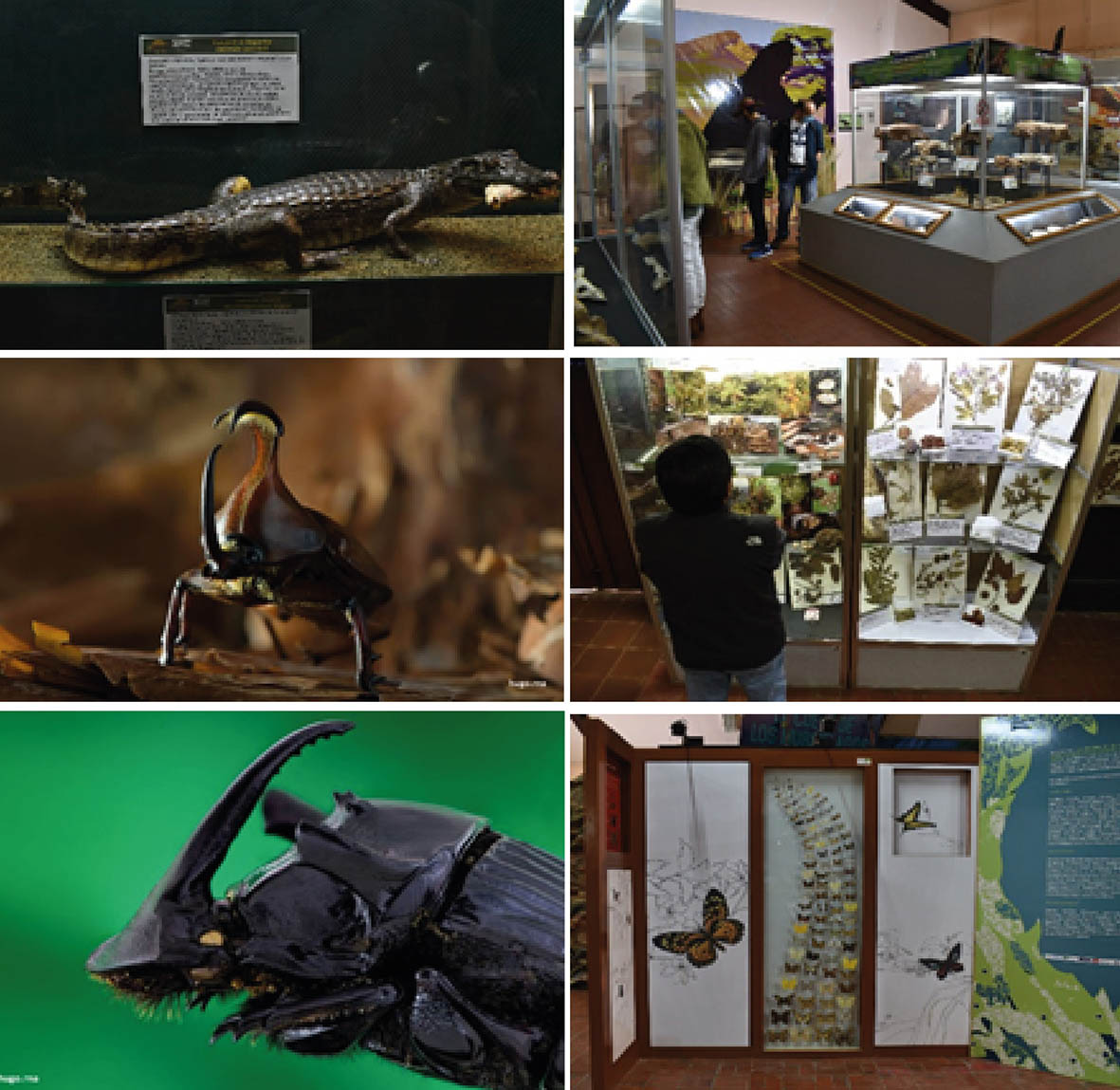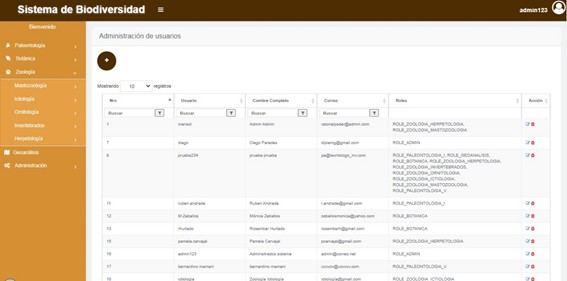Objective is to strengthen knowledge management and the articulation of the National Biodiversity Information System of the Plurinational State of Bolivia
Author: Bolivian Ministry of Environment and Water – Vice-Ministry of Environment, Biodiversity, Climate Change, Forestry Management and Development – General Board of Biodiversity and Protected Areas
Contact: ealiagar@hotmail.com
The Biodiversity Information System (SIB, in the Spanish acronym) of the National Museum of Natural History (MNHN) is a tool that allows validating, standardizing and updating biodiversity information on flora and fauna of Bolivia, including information on paleontology at the national level. This is done through the registration of specimens collected in the field, their taxonomic categorization, loan tracking and visualization of the information in a geo-referenced manner.
Currently much of the information of the National Museum of Natural History is still stored in Excel spreadsheets and physical catalogs, in view of the large amount of information, a process of prioritization and verification of the information contained in the Botany, Zoology and Paleontology Units is required for digitization and migration to the Information System.
The information contained in the collections is valuable and important as natural heritage (Figure 1). Currently, the Botany Unit maintains approximately 350,000 specimens through an agreement with the National Herbarium of Bolivia (Table 1).
| GROUP | No. SPECIMEN | % OF IDENTIFIED SPECIMENS | % OF SPECIMENS IN DIGITAL DATABASE |
| Dicotyledoneae | 200,000 | 70% | 80% |
| Monocotyledoneae | 100,000 | 70% | 80% |
| Gymnospermae | 20,000 | 80% | 60% |
| Pteridophyta | 30,000 | 80% | 90% |
Table 1. Scientific collection of the National Herbarium of Bolivia.
The Zoology Unit is structured in five sections: herpetology (amphibians and reptiles), ichthyology (fish), mastozoology (mammals), ornithology (birds) and invertebrates, under an agreement with the Bolivian Fauna Collection, has a scientific collection of vertebrates with more than 203,966 specimens distributed in 2167 species that represent 70% of the fauna reported for Bolivia; and of invertebrates with more than 300,000 specimens that represent approximately 10,000 species. Currently 200,000 specimens are catalogued.
The Paleontology Unit manages and safeguards a scientific collection of taphoflora fossils (239 samples), invertebrates (13,035 samples), ethological structures (284 samples) and vertebrates (26,795 samples), with a total of 27,187 specimens.
The Environmental Education Unit-UDEA manages a museum collection consisting of 120 invertebrate fossil specimens, 34 vertebrate fossils, 153 invertebrates, 477 vertebrates, 44 plants and 11 minerals.

Figure 1. Specimens in exhibition rooms at the Natural History Museum. (Photos: Wilma Angulo, Hugo Aranibar/ MNHN)
The use of the SIB improves the processes of creation, analysis and visualization of botanical and zoological information in the invertebrate, ichthyology, herpetology, ornithology and mastozoology sections; it also allows the management of paleontological information in an alphanumeric and geographic manner.
As the data is geographically managed, it allows the overlapping of different coverages managed by the country of interest for the research, so the system provides alphanumeric and statistical information quickly and efficiently on biodiversity by type of administrative boundary in Bolivia (department, province and municipality), as well as conservation units such as Protected Areas at national, departmental and municipal level; RAMSAR sites, in type of ecoregions; process that allows data capture, as well as synchronization and/or loading of information from external data sources (e.g., Google Drive, OGC services, etc.), as well as the synchronization and/or loading of information from external data sources (e.g., Google Drive, OGC services, etc.).
The SIB was built to work in collaboration and interconnection with other users and organizations at the national and regional levels, such as the National Biodiversity Information System (NBIS) and the Amazon Regional Observatory (ARO) of the Amazon Cooperation Treaty Organization (ACTO), processes that aim to contribute to improve the capacity to respond and transfer information efficiently for decision making at different levels.
It has also been possible to identify the shortcomings of current processes, needs and critical points and simplification of records in the area of paleontology and information on fauna and flora, which will allow the implementation of technological solutions to strengthen the MNHN in its mission to support the sustainability and conservation of the flora and fauna of the Plurinational State of Bolivia, especially species included in the CITES appendices, and which are in a category of threat.
National Museum of Natural History
The National Museum of Natural History (MNHN) (Figure 2) is a public scientific entity, which began its activities in 1978. Since 2018, it is a decentralized institution under the Ministry of Environment and Water (MMAyA) of the Plurinational State of Bolivia.

Figure 2. The National Museum of Natural History is located in the city of La Paz on Calle 26 in Cota Cota. It is currently open from Monday to Friday from 8:00 to 16:00. MNHN exhibition rooms (Photos: Wilma Angulo)
The MNHN aims to contribute to the sustainability of the natural systems of Mother Earth and its components, through scientific research, the management of scientific collections under its custody, the development and mobilization of scientific knowledge and the dialogue of inter-scientific knowledge about the life systems and natural heritage of the present and past of the Bolivian people.
Cooperation
In the framework of the strengthening and implementation of the National Biodiversity Information System of the Plurinational State of Bolivia, the MMAyA, through the General Board of Biodiversity and Protected Areas (DGBAP), seeks to strengthen the management of information and knowledge of the country’s biodiversity through the establishment of a National Biodiversity Information System.
In this context, ACTO, through the Bioamazon Project, in coordination with the MMAyA through the DGBAP, supported the strengthening of information management and knowledge mobilization through the implementation of the BIS within the MNHN. This initiative was implemented under Component 1 of the Bioamazon Project, which seeks to improve and balance the level of information and knowledge management by supporting and strengthening the Biodiversity and CITES information systems of ACTO member countries.
The design, development and management activities of the MNHN information system began in June 2020, as a result of a coordinated inter-institutional work with the company Boliviana de Innovación Tecnológica Satelital (BITS).
Thanks to the cooperation of ACTO, the development of the Biodiversity Information System has included an investment of US$ 18,000.00, as well as an investment of US$ 60,910.00 in equipment and work material.
However, once the first phase of the construction of the SIB platform has been completed, the identification of priority information to be transferred to the SIB is currently underway, as well as the process of correcting and validating the information in the paleontology, botany and zoology units and the support in equipment for an additional amount of approximately US$56,000.00.

Figure 3: Biodiversity Information System GeoViewer

Figure 4: Biodiversity Information System user administration platform.

Figure 5: Platform for entering data by species in the Biodiversity Information System.
Published in the Bioamazon Newsletter, issue n. 8, March-April 2021.











